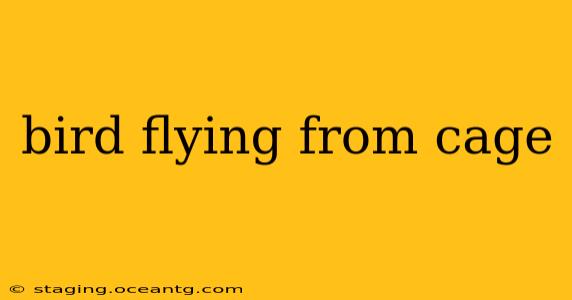The image of a bird escaping its cage is a powerful symbol, resonating across cultures and time periods. It evokes feelings of freedom, liberation, and the pursuit of independence. But the act of a bird flying from its cage, while seemingly straightforward, speaks to a much more complex reality encompassing both exhilarating freedom and the daunting challenges of transitioning to a new life. This article explores the symbolism, the practical implications, and the questions surrounding this evocative image.
What Does It Mean When a Bird Flies From Its Cage?
The symbolic meaning of a bird escaping its cage is multifaceted and often depends on the context. Generally, it represents the breaking free from confinement, oppression, or limitations. This can be interpreted on a personal level, representing overcoming adversity, achieving independence, or finding one's own path. On a broader scale, it can symbolize the fight for freedom and liberation from societal constraints or political oppression. The bird's journey after escaping often represents the challenges and triumphs of navigating a new reality.
What are the Challenges a Bird Faces After Escaping Its Cage?
While the escape is often celebrated as a victory, the bird now faces a multitude of challenges. These challenges include:
- Finding Food and Water: A caged bird is accustomed to a regular supply of food and water. In the wild, it must now forage for sustenance, a skill that may not be fully developed.
- Navigating Predators: The open world is fraught with dangers, including predators that pose a significant threat to its survival.
- Finding Shelter and Protection from the Elements: The cage offered protection from the weather. Now the bird must find suitable shelter to protect itself from the elements and predators.
- Establishing Territory and Social Structures: Depending on the species, the bird might need to establish its territory and interact with other birds, requiring social skills and adaptation.
What happens if a pet bird escapes its cage?
If a pet bird escapes, the situation can be quite stressful for both the bird and the owner. The bird's survival depends heavily on its species and its ability to adapt to the outside world. For example, a domesticated bird that has never had to forage for food will face immense difficulties. Owners should take immediate action to try and retrieve their escaped pet, consulting avian experts and local animal shelters.
Is it cruel to let a bird go free from a cage?
Whether it's cruel to release a caged bird depends entirely on the circumstances. Releasing a bird that has been kept in captivity for its entire life could be harmful, even deadly. Such a bird lacks the essential survival skills necessary to navigate the wild. However, if the bird is an injured wild bird being rehabilitated, releasing it after its recovery is crucial to its wellbeing.
How do I help a bird that has escaped its cage?
If you encounter a bird that appears to have escaped its cage, consider the following:
- Assess the bird's condition. Is it injured or distressed?
- Attempt to locate the owner. Is there a visible identification tag or band? Look for posters or online listings.
- If the bird appears injured or unable to care for itself, contact a local wildlife rehabilitator or animal rescue organization.
- If the bird seems healthy and capable of fending for itself, provide it with a safe place to observe for a short period before moving away.
The symbolism of a bird escaping its cage is a powerful and enduring one. It underscores the inherent human desire for freedom and self-determination. However, it also reminds us of the complexities and challenges inherent in transitioning from a sheltered environment to the unknown. Understanding these complexities allows for a deeper appreciation of both the symbolism and the very real challenges faced by birds—domesticated or wild—when they break free from confinement.
